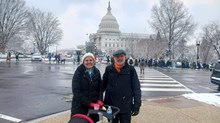How many "base communities" are there in Brazil? And how healthy is the liberation theology that spawned them?
The New York Timesrun-up story to Pope Benedict's visit to Brazil wants you to believe that reports of liberation theology's demise are greatly exaggerated. Despite official attempts to suppress this Marxist version of politicized Catholicism, says the Times, there are 80,000 active base communities in Brazil's vast territory.
The Associated Press is more conservative. It estimates the number that have been active in the past at about 60,000.
Neither the Times nor the AP sources its numbers.
The Economist, a news magazine that is supposed to be good with numbers, does not offer an estimate. It only reports that the notably pro-liberation 1968 Medellin conference of bishops "spawned innumerable ?base communities,'" and reports that their numbers are now in decline.
The numbers the Economist does cite show an overall decline in the Roman Catholic market share in Brazil, a point also made in the AP report.
In Brazil, the world's largest Catholic country, the church has lost adherents at a rate of 1% a year since 1991, mainly to Pentecostal churches. Fewer than three-quarters of Brazilians are now Catholics while 15% are Protestants (known locally as "evangelicals").
For the sake of comparison, the World Christian Database estimates more than 80% of the overall population of Latin American is Roman Catholic.
The shifts are not only in the direction of Pentecostal Protestantism, says the Economist, but also in the direction of charismatic-style Catholicism. At least half of active Catholics in Brazil have gravitated toward the charismatic movement. "The Catholic response to the Pentecostal challenge is to imitate it."

Support Our Work
Subscribe to CT for less than $4.25/month


















